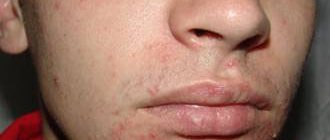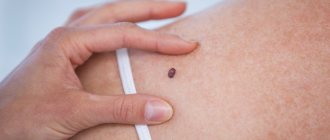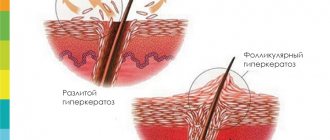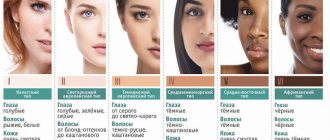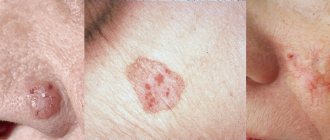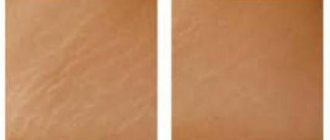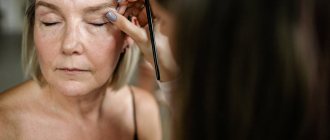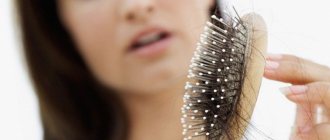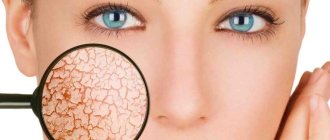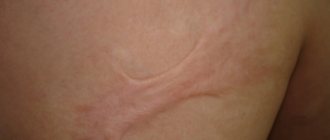One of the patients, a French teacher, told the following story: “At the beginning of her career, she was asked to help a little with translation for a Swiss journalist who flew to St. Petersburg on business. During their first meeting, the Swiss immediately asked if she knew the technique of simultaneous translation. The girl answered in the negative and decided that the interview was over, but the employer surprised her by saying that it no longer mattered, and in an hour they should be in the mayor’s reception room. At the moment of this strong experience, she accidentally saw her reflection in the mirror. The picture was frightening: the whole face and neck were covered with bright red spots, which were miraculously set off by the purple dress. For the rest of the time, she was no longer worried about how she would cope with simultaneous translation, but whether she would have time to turn pale.”
Fortunately, the story ended positively in every sense, but how many unpleasant moments can untimely vessels cause?
Skin health is largely a matter of vascular health. The physiological supply of nutrients to the skin and the normal course of thermoregulation processes are possible only with adequate functioning of the microvasculature. Normally, microcirculation is provided by the arteriolar choroid plexus (subpapillary - located on the border of the papillary and reticular layers of the dermis and subdermal - located on the border of the dermis and subcutaneous fatty tissue) and the superficial and deep venular choroid plexus.
Thermoregulation is provided by deeper vessels: mainly subcutaneous arterial and larger venous plexuses.
A number of exogenous and endogenous factors can have a damaging effect on the vascular wall:
- Hormonal and neurogenic factors
- Sharp fluctuations in high and low temperatures
- Mechanical skin damage
- Digestive diseases
- Ultraviolet irradiation
Let us consider the mechanisms of action of the most significant factors in a little more detail.
Hormonal and neurogenic factors
Estrogens influence the sympathetic nervous system by acting on 2-adrenergic receptors, which leads to vasospastic reactions. Starting from a certain age (about fifty years), the production of estrogens and progesterones decreases in the female body. This condition is very often accompanied by a feeling of heat, temporary, sometimes long-lasting facial hyperemia.
In general, vasospastic diseases and reactions (Raynaud's phenomenon) are more common in women and are more common during the reproductive period. During pregnancy, a decrease in the vasospastic readiness of facial skin vessels is often observed. Microcirculation in the facial skin varies throughout the menstrual cycle.
Causes of redness on the skin
The main causes of erythema on the skin are: Redness of the skin
- irritation: mechanical, high and low temperatures, chemicals;
- allergic reactions (urticaria);
- trauma (redness around the scratch);
- insect and other animal bites;
- autoimmune diseases, for example, eczema, psoriasis;
- infections: viral, bacterial, fungal;
- venereal diseases;
- dermatitis of various origins;
- In young children, a common cause of redness is diaper rash.
Typically, redness is accompanied by swelling, pain (more typical for infections), itching (more typical for allergic conditions).
As you can see from the list above, redness is a symptom of many skin conditions. It is often combined with other skin elements: blisters, ulcers, pustules, nodules, etc. The combination of signs makes it possible to suggest one or another diagnosis.
Sharp fluctuations in high and low temperatures
The effect of cold on the condition of blood vessels should not be underestimated - the first reaction to a decrease in temperature is a sharp vasospasm in order to reduce heat transfer. Subtle mechanisms of autonomic regulation are activated, followed by compensatory vasodilation.
Many clinical symptoms of prerosacea and rosacea develop through this mechanism.
The autonomic nervous system has both direct and indirect effects on the microvasculature. Normally, the vasoconstrictor effect is exerted by norepinephrine, which acts on alpha-1 adrenergic receptors; vasodilator - adrenaline acting on beta-2 adrenergic receptors of smooth muscle cells of arterioles.
The production of acetylcholine is accompanied by dilation of the vessel and an increase in the speed of blood flow in it (due to stimulation of NO production through M receptors). This vascular response is called endothelium-dependent dilation. A mechanism of endothelium-dependent vasoconstriction associated with the synthesis of endothelin-1 and 20-HETE in the endothelium is also identified.
Autonomic dysfunctions contribute to disruption of homeostasis and adaptation of the body to various environmental influences and lead to disruption of the skin structure, increased permeability of the vascular wall, decreased barrier functions of the epidermis and create conditions for the development of inflammation in the skin.
Many clinical symptoms of prerosacea and rosacea develop through this mechanism.
Prevention
To prevent skin problems, it is recommended:
- Avoid direct sunlight, apply sunscreen to your face before going outside;
- wear clothes made from natural fabrics that cover the skin;
- use high-quality cosmetics;
- do self-massage of the face;
- take vitamin complexes;
- to live an active lifestyle;
- get enough sleep;
- to refuse from bad habits;
- avoid stress;
- treat diseases in a timely manner.
A cosmetologist at our medical center will select and provide the correct care for your skin, and will also tell you about care at home.
Digestive diseases
Diseases of the gastrointestinal tract can indirectly affect vascular health. Irritation from the mucous membrane of the gastrointestinal tract is transmitted through the branches of the vagus nerve to its nuclei, the excitation passes to the nearby nuclei of the trigeminal nerve and through the branches of the latter enters the central zone of the face, causing vasodilation.
Recent studies confirm that the bacteria Helycobacter pylori persisting in the gastric mucosa contributes to the disruption of neurochemical regulatory mechanisms, which in turn lead to vasodilation.
My facial skin is red – is this rosacea?
Redness on the face is a symptom of many dermatological diseases, including rosacea. The difference is that rosacea is dilated blood vessels visible on the skin. In other words, a capillary network. Those with light, thin, sensitive skin are most susceptible to the condition. Couperosis on the face is localized on the cheeks and sides of the nose, sometimes accompanied by a burning and tingling sensation. This can be an independent manifestation of skin changes, or it can be one of the symptoms of rosacea, a chronic dermatological disease with an undulating course.
Ultraviolet irradiation
The sun is life! We know how important vitamin D is for beauty and health, but we must not forget about the harmful effects of ultraviolet rays.
In particular, it was found that 50% of UVA rays penetrate the skin to the papillary and reticular layers. They damage the endothelial cells of blood vessels and the basement membrane of the lymphatic microvessels of the skin, which leads to disruption of blood outflow.
As a result of adverse environmental influences and violations of internal regulatory mechanisms, the number of patients suffering from disorders of skin microcirculation is increasing - seeking help as cosmetic defects develop.
We are faced with the task of increasing the tone of the vascular walls and restoring their structure, eliminating the signs of sensitive skin (erythematous-squamous spots, rosacea, angioneurosis) and the associated discomfort.
As a result of adverse environmental influences and violations of internal regulatory mechanisms, the number of patients suffering from skin microcirculation disorders is increasing.
Especially to solve these problems, ]Pevonia Botanica[/anchor] has developed a line of RS2 products for very sensitive skin with microcirculation disorders.
Main active ingredient : licorice extract
, contains 18-beta-glycerrisic acid.
The medicinal properties of licorice were known long before the discovery of its component composition; modern scientific research has proven that glycyrrhizic acid is a unique natural compound with anti-inflammatory, reparative and vasoconstrictor effects. The composition also includes green tea, incense, B vitamins and microelements - all together this has a prolonged restorative effect on the structure of the vascular wall, strengthening blood vessels, reducing the manifestations of rosacea and congestion.
Treatment methods
First of all, the cause of the pathology should be eliminated - the underlying disease should be cured. For infectious diseases, the doctor will prescribe antibacterial, antiviral or antifungal drugs. If the problem is due to an allergy, he will recommend antihistamines. In stressful situations, sedatives will come to the rescue, and in case of intoxication, detoxification therapy.
Various procedures will help to cope with defects:
Peeling
Renews the skin, evens out its tone, eliminates oily shine and unevenness, eliminates pigment spots, and smoothes the texture. The type of peeling is selected depending on the problem.
Chemical peeling, which contains acids, has an effective effect on hyperpigmentation. For minor pigmentation, a superficial peel (milk, almond, glycolic, salicylic, retinoic) that exfoliates the epidermal layer is sufficient. For more pronounced pigmentation, medium peels (PRX T33, Jessner) that penetrate the skin more deeply will be needed.
Mechanical peeling (microdermabrasion, dermabrasion) removes age spots, scars, acne, ingrown hairs, evens out unevenness, and eliminates age-related changes.
Depending on the condition of the skin, the cosmetologist can choose carbon, ultrasound, or radio wave peeling.
Laser resurfacing
Removes skin defects (pigment spots, scars, wrinkles, unevenness, oily shine, blackheads), and also activates the synthesis of elastin and collagen, which promotes skin rejuvenation, gives it firmness and elasticity.
Mesotherapy and biorevitalization
Injections of meso-cocktails and hyaluronic acid eliminate hyperpigmentation, increase skin turgor, restore natural color, have a rejuvenating effect, even out the tone and texture of the face.
Phototherapy
Light exposure destroys cells containing an increased amount of melanin, which helps get rid of age spots.
PRP therapy, plasma lifting
The client is given his own platelet-rich plasma. As a result, the skin is rejuvenated and dark areas are brightened.
Cryotherapy
The skin is exposed to low temperatures - massaged with ice or liquid nitrogen. As a result, pores are narrowed, skin tone is evened out, acne, age spots, wrinkles, and scars disappear.
Ozone therapy
Injections of an ozone-oxygen mixture saturate cells with oxygen and moisture, activate metabolism and blood circulation, eliminate blackheads, redness, wrinkles, scars, and even out skin tone.
Treatment of facial skin diseases
As mentioned above, the first step to successful treatment of any skin disease is to identify the factor that provoked it, since the entire course of treatment depends on this. It should be noted that self-medication for skin diseases on the face can be not only useless, but also dangerous.
If you are faced with skin problems on your face and want to get rid of them once and for all, then visit the ImageLab medical center, whose specialists will promptly make the correct diagnosis and prescribe an effective course of treatment.
The main thing is not to delay dealing with facial skin diseases, since even simple sagging or dry facial skin can ultimately turn out to be a serious disease requiring professional treatment.
Causes of facial skin diseases
Any skin diseases on the face do not occur on their own. They are, as a rule, provoked by third-party factors, with the search for which the treatment of any skin disease begins.
Improper skin care This is the most common cause of all kinds of problems and diseases of the facial skin. Thus, improper care can lead to severe contamination of the dermis and the proliferation of bacteria on it, which can ultimately lead to quite serious consequences.
Heredity It is very difficult to put in order the skin, the poor condition of which is caused by a person’s heredity. However, proper care for her, a healthy lifestyle and proper nutrition can significantly improve her condition.
Lifestyle Frequent stress, an unfavorable work environment, smoking, drinking alcohol, and poor-quality food - all this can affect the condition of the facial skin and even lead to skin diseases.
Diseases of internal organs As a rule, skin diseases on the face indicate improper functioning of the digestive system, kidneys or blood vessels. Also, weakened immunity, viruses and infections can provoke the appearance of acne, age spots and other skin problems.
Problems with the nervous system The main causes of various small rashes on the skin of the face are stress, which, unfortunately, awaits a modern person at every turn.
